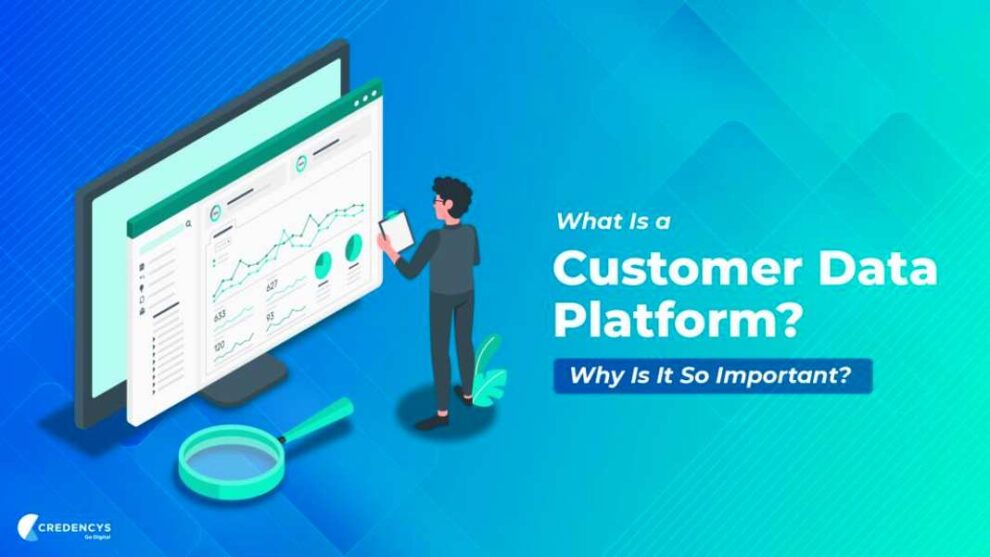Customers play a crucial role in the growth and development of any business. It is important to target the right customer category for sales growth. The sales of the product depend on the customer’s needs, expectations, etc.
Thus, it is important to adapt the customer engagement mechanism in their digital and eCommerce environment. The new engagement models require real-time data collection and analysis. It is important to collect customer data, evaluate it and make business strategies depending on the analysis. This enables boosting the business.
What is a Customer Data Platform (CDP)?
The customer data platform (CDP) is a tool useful for marketers for transforming their user data to convert it into an impactful customer experience. This CDP captures the real-time digital signals from the users as they interact with the different channels. This analysis helps in predicting customer behavior and needs to be based on their current and previous trends.
The CDP supports marketers in activating customer insights for optimization and personalization. These details can be obtained from various channels and can be shared across the entire ecosystem. This analysis will help in improving the alignment across the campaigns.
The customer data platform enables the creation of persistent, unified customer databases that can be used by the different systems to understand the customers and enhance the customer experience. Digital marketers have been implementing the CDP for delivering the best customer experience.
Many organizations that need to improve their sales are focusing on CDP investments. The customer data is very vast and is important to use this data efficiently. There are several customer data platforms available and these are several factors that an organization needs to consider while selecting the best suitable CDP.
Features & Capabilities of CDP
Certain features are essential in the customer data platform that an organization needs to look for while selecting the best suitable CDP system. The Major CDP capabilities include:
Data collection: The robust CDP product should be able to ingest first-party, individual-level customer information from multiple sources. This data can be taken online or offline based on real-time circumstances and provides limitless storage of this data. This data will remain in the system till it is needed for processing. This data includes the first-party identifiers, attributes, behavior, etc.
Profile unification: The CDP tool should have the ability to consolidate the profiles at the personal level and connect these attributes to their identities. It should be able to link multiple devices with a single individual once the person is identified. This will help in preventing duplication of the customer record. Some of the CDP solutions support third-party data matching and aggregation of the customers into a single account.
Segmentation: The CDP tool should act as an interface for enabling the marketers for creating and managing the different segments. It should provide basic offerings and support the creation of rule-based segmentation. Some CDP tools have advanced features for segmentation that includes automated segment discovery, propensity modeling, predictive analytics, the ability for importing and deploying custom models built for advanced analytics, data science environment, etc.
Activation: The CSP should have the ability for sending the segments along with the instructions for their activation for its use in email campaigning, mobile messaging, advertising, etc. certain CDPs have additional advanced support for suppression, consent-based filtering, personalization, A/B testing, journey orchestration, recommendations, etc.
Top 5 Advantages of Using CDP
The several advantages gained by the business by implementing the CDP include:
Eliminating data silos: CDP enables breaking down the data silos thus converting the fragmented collection data, email address, purchase history details, etc. into dynamic data in real-time. It also helps in the removal of duplicate data and provides a 360-degree view of customer details by performing data analysis and segmentation. It also helps in providing a personalized experience to the customers thus enhancing brand confidence.
Unlocking AI-powered personalization: The AI-powered CDP can help marketers to provide insights for deciding the different levels of customer engagement. It provides an opportunity for upselling the products to relevant customers and also predicts their conversions.
Data protection and privacy: CDP enables in complying with the existing and emerging data protection and privacy legislation. It thrives to keep customer data safe from potential threats and perform regular audits.
Increase operational efficiency: CDP allows seamless integration with the existing tech stack thus reducing the setup cost, and saving time, effort, and IT resources. It allows the team to concentrate on track, building, and optimizing new models.
Improve customer lifetime value: Customer lifetime value ((CLV) represents the total worth of the customer over its relationship with the brand. CDP provides the ability to identify high-value customers and provides personalized customer experiences. This will help in customer loyalty and retention.
Common Challenges For Implementing a CDP
There are several common challenges faced while implementing the customer data platform and integrating it with the currently available systems. These challenges include:
Focus on a specific problem: Some customers have specific use cases or issues that need to be resolved. These end-users utilize the capabilities of the CDP for solving these issues. They require support for a particular issue like data management while looking to enrich their leads. There are 3 different levels of CDP data management, scoring/ recommendations, and activation.
Transitioning off of point solution: Some customers approach the CDP for replacing the component piece of their tech stack. They may have the vendor ready but approach looking for enriching their database. They may not be willing to make an immediate investment in the implementation of the full CDP solution. They might be looking for some small plug-ins.
Integration into existing processes: Most of the N2B market teams have a complex set of technology, workflow, and processes in place. These teams make some adjustments and tweaks over time and while implementing the new CDP there arise some challenges in scoring, lead management, routing, territories, etc.
Alignment between teams: CDP needs to be aligned across the different departments within the company and also within the companies. The marketing team is the epicenter of the CDP initiative and its job overlaps with several other departments within the organization. The different teams should be aligned if not it might lead to significant impacts on sales.
How to Choose the Right CDP?
Having the right CDP for your business allows you to leverage its benefits and experience your business growth. However, picking the right CDP software from the market will be always tricky if you are not aware of the upcoming factors.
Make sure you have enough knowledge of the factors mentioned below before picking CDP software for your business.
Team Establishment: As the CDP platform ingests data from various departments of an organization, the business stakeholders need to communicate the importance of CDP’s value across the organization. Also, a separate team must have members from all departments to be established for handling CDP platform for better management.
Know Your Business Requirement: Understanding your business need well before accomplishing CDP is important. So that you can pick the right platform that can deliver value across your organization. Having the right CDP will allow businesses to deliver exactly what customers are looking for and to gain better digital customer experience and customer loyalty.
Defining Requirements’ Priority: In today’s market, you can find numerous CDP software offering various features and functionality. In those picking the one that will meet your business goals and objectives is vital. For that, you need to have a better knowledge of prioritizing your CDP requirements and make adjustments accordingly to select the best.
Knowledge Over the Vendors: You need to know that all vendors are not the same and are not native. Based on your business need and priority you need to analyze the vendor’s ability and pick their CDP which is purposefully built for enterprise benefits. So that you can leverage all its benefits and ensure the picking CDP is a future-proof tech stack for your business.
Understanding User’s Role, Skills & Processes: Picking the right people with desired skills from your organization to handle CDP don’t need to be done right after the deployment of CDP. To leverage CDP and achieve better ROI, business stakeholders need to have an insightful vision of picking the right professionals from digital marketing, data science; data analysis, IT, and customer support departments and assign appropriate roles to handling CDP software.
Conclusion
Customer data platforms play an important role as it helps in the collection and curation of customer data. There are several different types of customer data platforms available in the market based on different categories. The organization can select the best suitable CDP based on their needs and requirements.
Implementation of the CDP will help in increasing customer loyalty, revenue, and customer retention as it helps in removing the data silos while consolidating the real-time data from the different online and offline channels for creating a single customer view. It enables live audience tracking for understanding customer behavior across different touch points thus helping in targeting.



















Add Comment